An Interview with Shari & Hutch: 11 Years Traveling with Solar!
Shari and Hutch are full-time RVers who have taken their 1957 solar powered camper all over the North American continent. They just celebrated 11 years of living and working from the road, their "Nomadiversary” if you will, with the tiny canned-ham style camper (all 72 sq. ft.) that they lovingly refer to as “Hamlet.”
They have been all over the North American continent – all 50 US states and 10 Canadian provinces – and have taken Hamlet to all 51 of the US national parks you can drive to, as well as 14 Parks Canada national parks. And, they have plans to go to Baja this winter.
Being early adopters of the solar powered roadlife, they have over a decade of experience living and traveling off-grid, as well as teaching others how to make the most of what solar power can do! They share their adventures and seminars through their website and social media handle “ Freedom in a Can.”
The Renogy team had some burning questions for them and about their inspirational journey!
Can you briefly describe your journey into the off-grid RV lifestyle and what inspired you to make the switch?
Hutch: In the fall of 2010, I came home late one night from work, tired, and hungry. Before I fully entered the house, Shari hollered from the bedroom, “Promise me you won’t be mad!” She had already purchased our little camper in a bid on eBay, and her message was clear, “I’m leaving, and you’re invited.”
Shari: I’d had “that day” at work, and I just couldn’t see a future for myself anymore in the university career I had for 18 years. When I went home that night, I opened the laptop and found our little Hamlet just waiting for our bid. I didn’t want to just move to another university only to run into the same problems in another place. No, I needed a more radical departure.
We both love to travel internationally, but hadn’t really seen much of our own country, so we thought we would take a mid-career break for a year or two before deciding what was next. We were experienced campers who love backcountry travel so taking a long meandering road trip in a camper, even one as small as ours, felt like luxury accommodations. We still love to camp in a tent and take extended breaks far from roads and powerlines.
Solar was always a part of our plan. We had taught some classes on sustainability at the University where we worked so we knew that we wanted to give solar power a try in our rolling, tiny home. To say that we were early adopters of this technology is an understatement. Our first panel was an 80 Watt rigid panel that we used to put out in the campsite on a guitar stand with a bungee cord holding it down. It was the original solar suitcase! We used to get a lot of strange looks and questions about what it was, and if it worked.
As our experience with solar increased and our system grew in both power, size, and complexity, we realized that others were hungry to learn how to live this lifestyle. Within just a few years, the questions took on a much more specific nature: “How much could we run?” “What kind of batteries did we have?” and “What was the size of our inverter?” Folks have made the switch from doubting to believing that alternative energy can power their lives – especially in smaller dwellings like RV’s and boats.
We love being educators in a different way than in our previous careers. There is so much more information, not to mention products, that cater to the off-grid RVer or cabin builder now. Even those with no previous experience have resources that can guide them to DIY their own solar powered travel dreams. We are so excited to see this trend and help be a part of a more sustainable future!
What type of solar setup do you have on your RV, and how did you decide on that particular configuration?
Currently, we have 2 x 100W flexible panels, a 100W solar suitcase, 2 x 100Ah Self-Heating LFP batteries, 700W inverter, and a Renogy ONE Core monitor. We also have a 50A LFP battery which runs the fridge in the back of our truck. It gets charged by the 30A Dual Input DC to DC charger, which can also charge the house battery bank while driving via a simple switch, wiring, and Anderson connector between our truck and trailer.
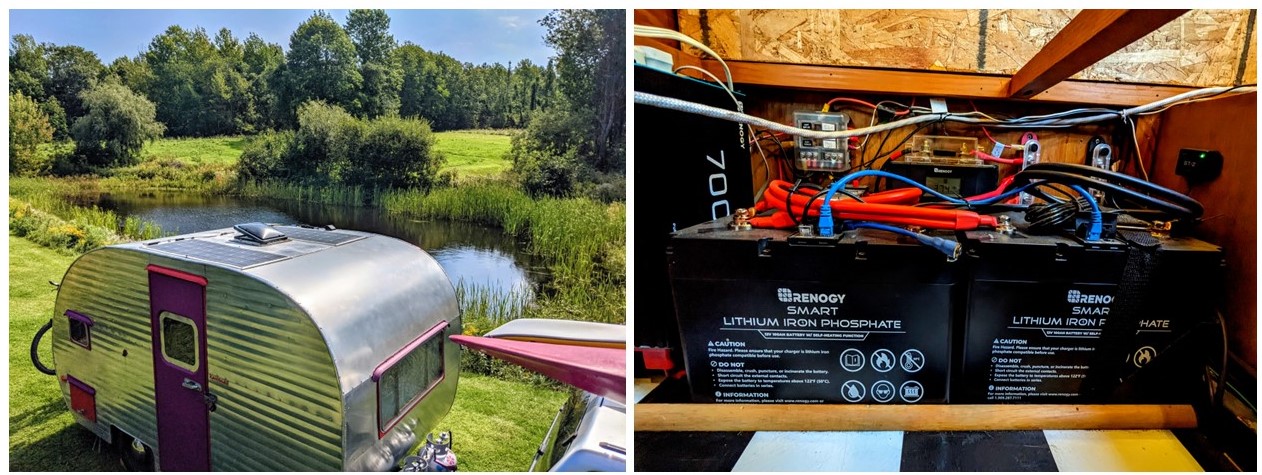
As we mentioned previously, our system started very small back in 2012. When we started over a decade ago, the only information available was designed for the engineer or electrician. A friend in the alternative energy industry helped us find what we needed and off we went…rolling with solar from day uno. As the market for RV solar evolved, our system evolved with it. In 2018, we began upgrading to Renogy equipment and LFP batteries, as well as more powerful solar panels. We couldn’t be happier with our current system, it offers the right balance of charging options, weight and power density!
We chose flexible panels for the roof of our 1957 Sportcraft Camper, because it’s a vintage and we wanted lightweight, low-profile panels. We have the option of the solar suitcase for times when we want to park in the shade and have our panel in the sun or for cloudy days when we need more solar surface area. We choose 2 x 100Ah LFP batteries because they fit our solar cabinet perfectly and the self-heating function is ideal for the times we are in colder climates. Since we don’t run multiple AC appliances all at once and have low energy needs overall, the 700W inverter is compact and perfect for our lifestyle.
How do you manage your energy consumption, especially on cloudy days or during extended periods without sunlight?
With our minimal power needs, we have more than enough battery power to run our lives and our mobile business. We recently upgraded to the new Renogy ONE Core to monitor our energy consumption coming in, our load, and it tells us how long we can run our current load. All of this combined allows us to plan out our day.
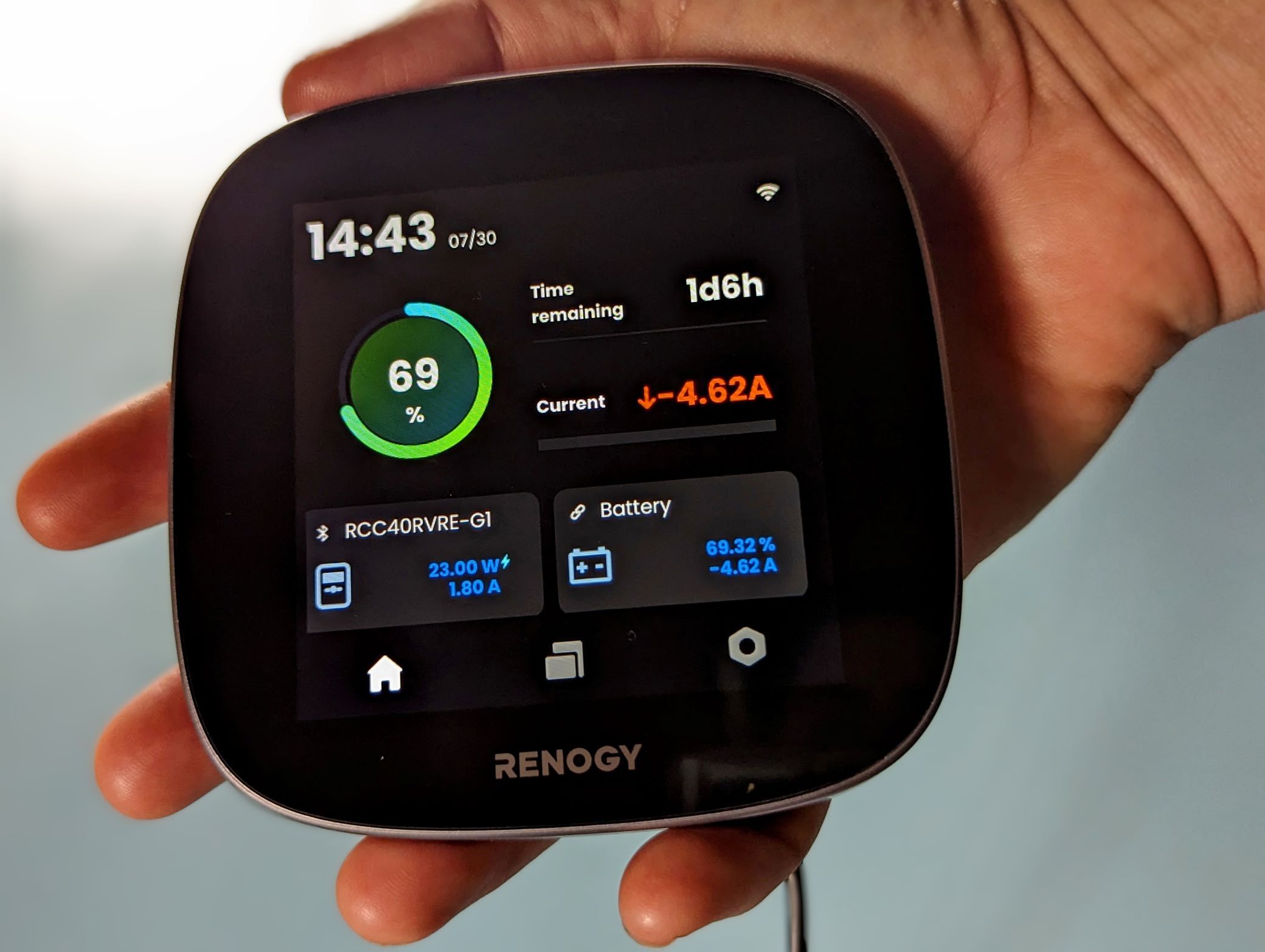
We also simply pay attention to what we are running and when, so that we are making the best use of the time when the sun is out. When our battery bank is close to full and we are getting good solar gain, we charge all of our battery-operated electronics, making good use of all the energy coming in, rather than wasting it. This is also the time to run less efficient AC appliances, making good use of sun power.
When it’s cloudy or raining outside, it’s often colder, and our refrigerator battery doesn’t need to be charged up as much, so we can switch to charging up our battery bank while driving using the 30A Dual Input DC to DC charger mentioned above. For every hour we drive we are able to charge up our 200Ah battery bank by around 20%.
If we are set-up and don’t plan to drive for a few days, our solar suitcase can help increase our solar surface area from 200W to 300W to help stabilize the depletion of our battery bank.
While this may sound overwhelming to people who are new to this lifestyle, it just becomes second nature when you live on the road with solar.
In addition to using our equipment efficiently, we keep our electrical needs lower than most people who live in a traditional home. This was one of our goals when we hit the road in 2012.
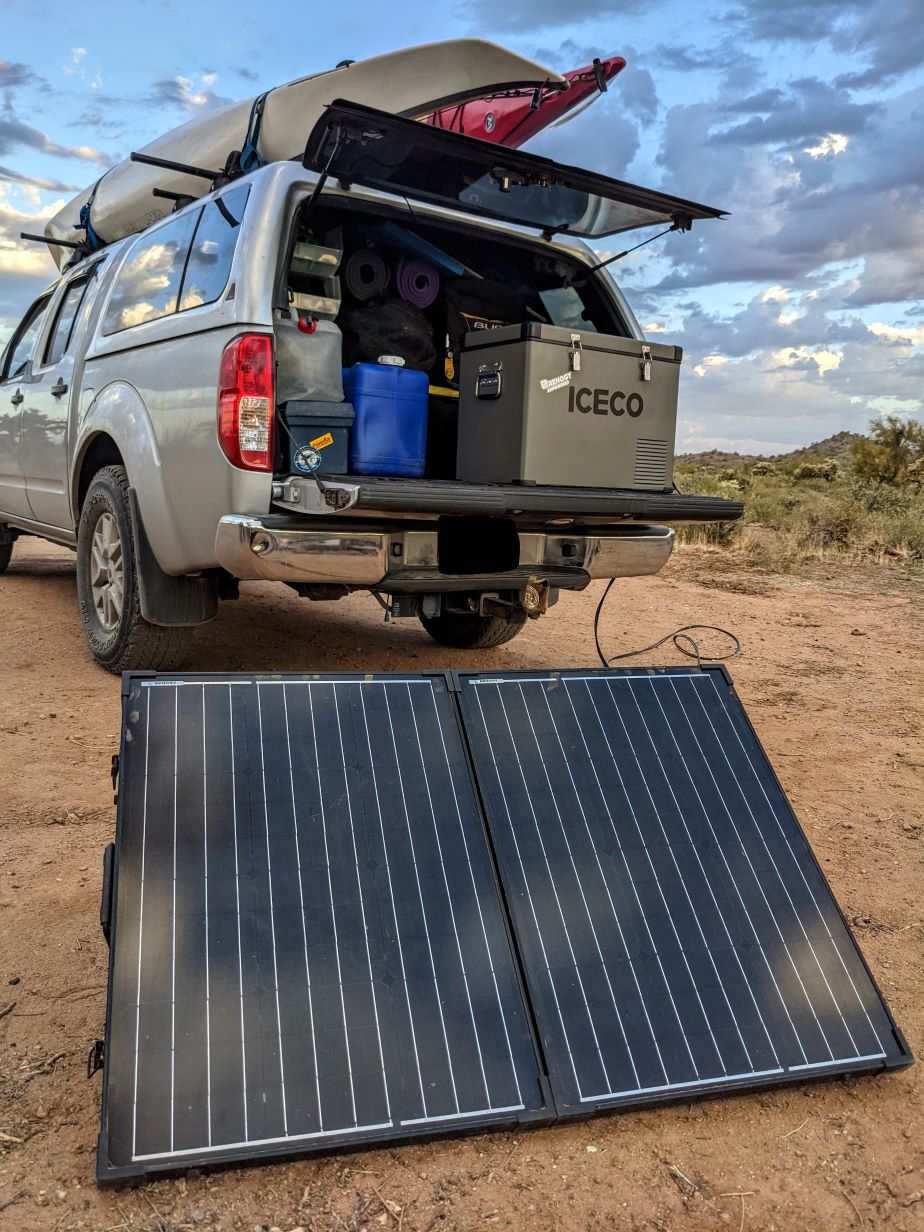
We have a 2-burner propane stove so we can make coffee with a kettle and a French press. It also serves as our toaster using a griddle, and we can make/reheat food in a skillet. We have a VERY efficient ICECO VL45 ICECO refrigerator that just sips energy. Using our truck’s engine as the main source of energy while driving, our 50A LFP battery charges back up every time we drive the truck for about 20 mins – to the store, trailhead, etc. Alternatively, if we are camping and don’t plan to drive, we use the 30A Dual Input DC to DC charger (solar + engine charge) connected to the 50 LFP battery and plug in our 100W solar suitcase to recharge the battery.
Very occasionally (maybe 1-2x per year), if we’ve gone more than a few days without sun and aren’t planning to drive much, we choose a campground with electrical hook-ups and recharge our battery bank using our AC to DC charger off of shore power.
What have been the biggest challenges you've faced living off-grid in an RV, and how have you overcome them?
As outdoor and environmental educators, living in an RV was a natural next step for us. We enjoy living outside and camping in rural places with more trees than buildings surrounding us. When we are in cities for more than a few days at a time, we crave space and being outside in beautiful places. So, we had the living outside part down before hitting the road.
But, living with solar as our main source of power was a learning curve for sure, especially with the rudimentary equipment that we installed in 2012. We launched in the autumn, and didn’t have a full understanding about how the short days and lower sun angle would affect our ability to charge. We also didn’t have enough power to get us through more than a couple of days without much sun. Needless to say, there was a lot of reading by candlelight or battery-operated lanterns early on in our travels! But we quickly became used to what we could run, for how long, and figure out an alternative when we didn’t have enough power. And as our needs and understanding grew, so did our system.
Early on in our travels, before we had a smartphone and all the apps and online resources were readily available, finding campgrounds, public land, water, grocery stores, laundromats, etc. was a bit more difficult. We used a map and “the force” to find many things, which are great skills to cultivate. Now, with everything available on the phone, it’s quite simple. We travel nearly reservationless and often don’t know where we are going to camp until we decide it’s time to stop for the night. Again, this was a learning curve for us early on, but is now 100% second nature.
Before wireless networks were widespread and Starlink came on board (yeah, remember those days?), we spent time in public libraries and coffee houses in order to get work done, check email, connect with friends/family online, etc. But, with so few places left where you can’t get internet, this is rarely a problem now.
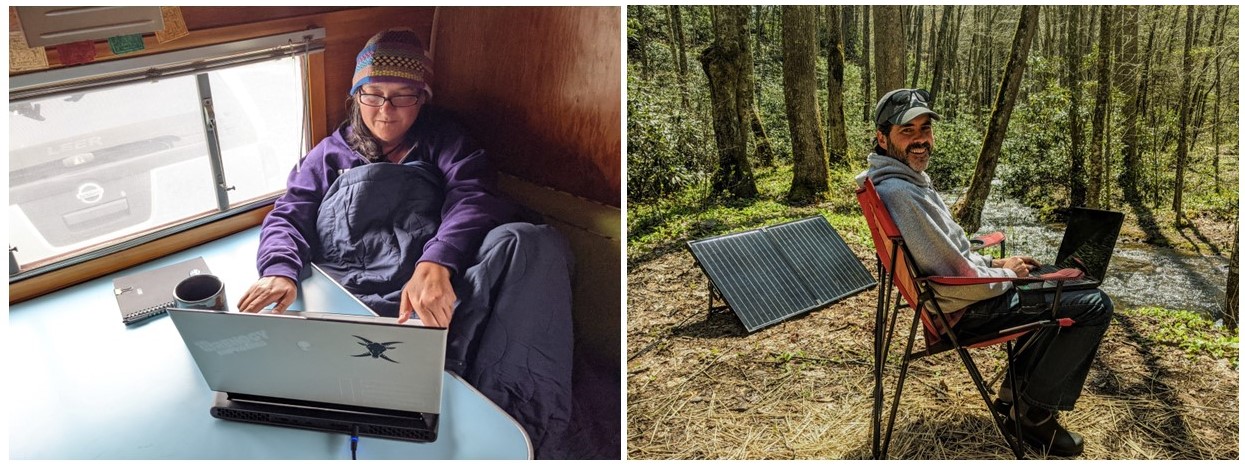
We LOVE to cook, so making an adjustment to not having all the kitchen and household appliances that we used to have in our home was a bit difficult at first. We just didn’t have the room to store all of the normal kitchen appliances. With some kitchen basics, as well as some creativity and a heavy dose of ingenuity, it has been fun to figure out how to do what we used to do with what we have now. We make great use of a flat top griddle, we bake anything and everything in a special Fry-Bake pan over a campfire or two burner stove, use a French press to make coffee, etc. The only electric appliance we have is an immersion blender to make soups, smoothies, cocktails, sauces, and more. This has simplified our life, our overall needs, and especially our budget. We’ve become more resilient and resourceful over the years, making us feel that we can face many challenges with a different level of fortitude.
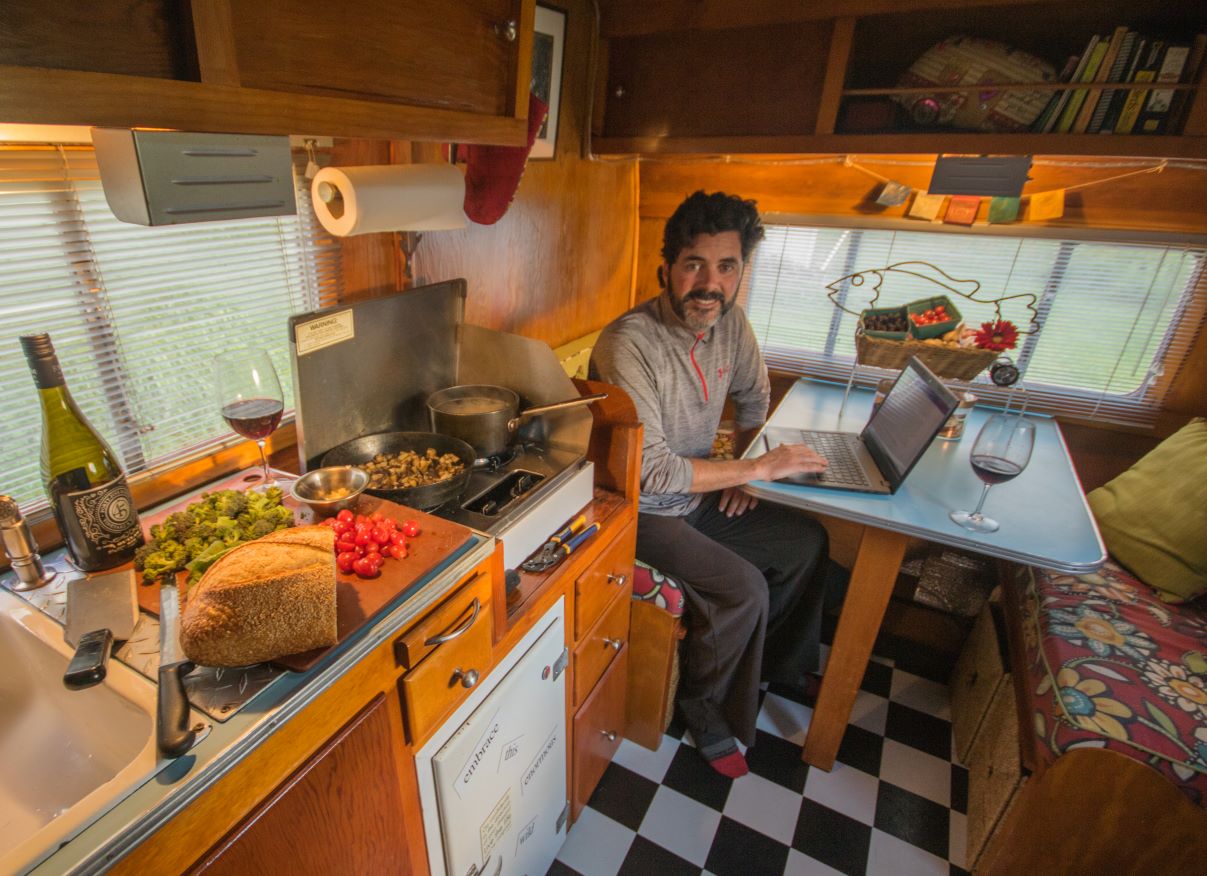
Oh, and shoes! It was easy to reduce the clothing we needed, but shoes are another story. While this refers more to living small rather than living off grid, we’ve gone through various iterations of how to deal with all of our shoes. And, we don’t mean the numerous fun or dress shoes that we used to have to coordinate with each outfit; we are talking about the day-to-day shoes like running shoes, flip flops, casual slide-ons, slippers, snow boots, cycling shoes, kayak booties, etc. We’ve gotten strategic over the years about what we really need and where to store them efficiently, which finally boiled down to storing a couple pairs of dress shoes that we don’t need as often under the bed and building a shoe rack in the back of our truck to manage our everyday shoes.
What are the most rewarding aspects of living off-grid and relying on solar power?
That’s both a tough question and an easy one as there is so much that we love about roadlife and solar. We love the simplicity of this lifestyle and being able to move slowly and intentionally through beautiful places. We love traveling 99% reservationless. We can linger in beautiful off-grid campgrounds or on public land, make use of Boondockers Welcome and Harvest Hosts locations across the continent, and move on quickly from overcrowded areas. We can set our own work and travel schedule, and have the time to explore rather than rushing from place to place and from reservation to reservation.
We have friends and family scattered across the continent and can visit without getting up in their space, because we have our own house with us. When they offer for us to plug in while we stay with them, we remind them that we are self-sufficient. We are often dubbed as the easiest houseguests ever!
Basically, we can do whatever we need or want to do when we want to do it since most of our basic life necessities are covered and our living expenses are very low.
We’ve also taken the time to volunteer in various places from organic farms to the national park service. We come with our own home and the time to help out. We are excited to be volunteering at the 51st Annual Balloon Fiesta in Albuquerque, NM in October!
How do you maintain your solar panels and batteries to ensure they're functioning at their best?
We occasionally check the solar panels for dirt / debris and clean them when necessary, but rain and wind usually takes care of this for us. The LFP batteries are relatively maintenance free. We just pay attention to the battery charge status to make sure they are charging as expected. We have literally never had a problem with them. Only once have we had a problem with a Renogy charge controller which stopped working and they replaced it within a week. We had an older PWM charge controller on hand, which we temporarily installed to hold us over.
If we’ve been on really bumpy roads, we’ll do a spot check of wiring to make sure all connections are still intact. Overall, the system is nearly maintenance free!
Can you give us an idea of the initial investment required to set up a solar-powered RV? How do the ongoing costs compare to traditional RV living?
While this is different for everyone, as every person and rig has different electrical requirements, most RVers spend between $2000-$8000 on a complete system. You can spend less than that, and you can certainly spend more. The total cost of our current system in 2023 prices is $2,600 (including all the panels, components, monitor, all of the wiring, fuses, and connectors). We have shared all of this information and wiring diagrams at the bottom of this page. If you plan out your system correctly, you shouldn’t need to upgrade anything unless your electrical needs change or you just “have to have” a new toy.
By living off-grid, rather than plugging into electrical campsites for the past 11 years, we have saved over $180K. Yes, you read that right! If we had paid for electrical campsites at an average of $50 per night nationwide for 365 days a year for the last 11 years, we would have spent $200,750. Instead, we have spent about $19,800 on low cost, off-grid campsites and public land in beautiful places – with the occasional splurge here and there.
Describe a typical day in your life. How does it differ from when you lived in a traditional home or relied on grid power?
Every day is different, which is exactly what we needed and wanted in order to break away from the grind of working in an office and for a large university. We had engaging careers, but at some point, they became bigger than we could manage and maintain some life balance – the juice was no longer worth the squeeze. We’ve found that we thrive on a lack of routine and being outside!
Overall, we spend a few hours of most days working, a few hours of most days hiking, cycling, or paddling, and we love to cook…so meals are somewhat of an event. Unlike our previous lives, we are able to dedicate more time to exploring our culinary curiosities .

Despite the fact that we left university life behind, we still consider ourselves educators to the core. We use these skills and experiences that we learned during our 18-year careers in different ways through writing, seminars, photography/videography, and teaching. In addition to being digital creators, we are both environmental and outdoor educators.
Being able to seamlessly blend our quest for adventure travel with our personal life and work life has been incredibly freeing. When we speak at RV Shows 4-5 times per year, we typically leave our rig behind and fly to the shows as they are often in places that we aren’t. This is very different from living in a traditional home and commuting to an office every day.
We are much more aware of our power consumption than we ever used to be. We don’t take flipping on a light switch for granted. We are always thinking about our power usage, which may sound exhausting, but it quickly becomes part of your day without giving it a lot of thought.
How does being solar-powered influence your travel decisions? Are there places you avoid or specifically seek out due to sunlight availability?
Since we have multiple ways to charge our batteries, running on solar doesn’t really affect where we travel. We’ve been from Maine to California and Florida to Alaska – all with no issues.
Two things that we do consider:
- When we travel in the summer: We don’t have air conditioning (or a solar system that could handle it), so we typically avoid very warm places in the summer. You won’t find us in Arizona in the summer, but you will find us in Canada, Alaska, or Maine. Typically, we go coastal, and up in both latitude and altitude during the warmer months. We have traveled through some hot places in the past, and just use fans and shade to stay cooler. We also seek out places near the water so that we can play in a lake, river, or the ocean during warmer days. We also avoid very humid places in the summer; we prefer to visit those places in the winter months.
- Campsite selection: When we are choosing a campsite within a campground, we keep potential solar gain in mind if we are planning to be there for more than a couple of days. But, our flexible solar suitcase is always handy when we have Hamlet parked in the shade of trees and we need to collect some solar energy. If we have run our batteries down a bit, we just switch our charging to DC to DC and can yield about 20Ah per hour while driving.

Do you have any backup power solutions in case of solar failures or emergencies?
Absolutely! We can run off shore power, but honestly this is very rare for us and we only need to do this once or twice a year. We can also use our AC to DC charger to recharge our battery bank with shore power. Being able to charge our battery bank while driving has been a game changer as well. In addition to all of these alternative resources, we can charge our small 300 Portable Power Station off of AC power, with the truck’s engine while driving, or with our solar suitcase. We’ve used this on occasion when we have low solar gain, aren’t planning on driving, and don’t have the option to plug into a campsite nearby.
What advice would you give to someone considering transitioning to an off-grid, solar-powered RV lifestyle?
Decide on how you are going to live off-grid. Are you going to park somewhere or move around frequently? How you use your rig is going to help determine the type and size of the system you’ll need.
Do the research to learn about how solar works. If you don’t have a math or science background (we didn’t!) it takes a minute to get your head around it, but there are many resources out there to do the hard work for you. We have an entire section of our website dedicated to FREE solar resources.
Plan out a system that can accommodate what you want to run. If you let someone else do it for you or you simply get what your friend’s have, it may be too big or too small. Everyone has different power needs. Also, build in room for growth, whether that’s adding more panels, more batteries, or larger equipment in the future. Finally, have alternative ways to charge, just in case. See details above!
Once your system is installed and you’ve used it for a few weeks, pay attention to your typical daily energy usage. Are you regularly drawing your battery bank down to its safe depth of discharge (DOD)? If so, maybe you need a larger battery bank, more solar, or you need to make some adjustments to your lifestyle/power consumption.
Learn how to troubleshoot your system. While you shouldn’t have to do much of this, it’s always important to know how to turn components off, isolate the issue, and be able to describe the problem to a technician.
Be patient. Making a major life change takes time, flexibility, curiosity and resiliency. Focus on what solar has allowed you to do -- whether that’s living more sustainably, saving money, or getting to travel the continent, or all of the above! In this case, the juice is worth the squeeze!
How has the off-grid and RV community influenced your journey? Are there any groups or resources you'd recommend to newcomers?
Over the years, we’ve met more and more people who’ve chosen to hit the road. It’s been fun to watch the trend toward being active outside and enjoying Mother Nature -- all with a focus on sustainability. We’ve enjoyed meeting newbies to roadlife as well as the few folks who’ve been on the road for even longer than we have. We’ve met, worked with, and made friends with people all over the continent as we’ve traveled!
There are so many different communities out there – from single folks to young couples with families to middle-aged working couples to retired folks…and everyone in between. Those of us who live the off-grid lifestyle enjoy a wide variety of dwellings from RV’s and vans to skoolies and vintage campers. Each of these groups converge at various rallies throughout the year, all across the country. It’s easy to find “your people” via social media or by simply searching online for groups.
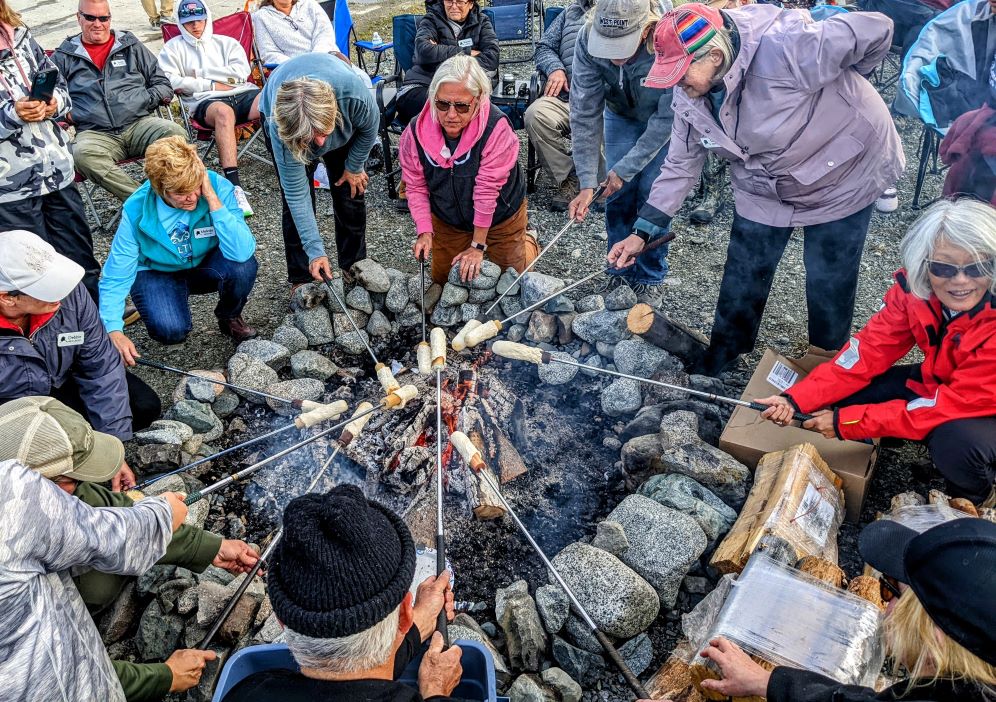
A couple of places many of these groups converge are at events and rallies surrounding RV shows, at one of the Escapees/Xscapers events, or at the Rubbertramp Rendezvous (aka RTR and WRTR) near Quartzite, AZ each January. These are great places to meet like-minded people, learn from experienced travelers, find travel companions, and make a ton of new friends.
How do you view your lifestyle in terms of environmental impact and sustainability?
We view the concept of sustainability from a couple of different perspectives. First there is environmental sustainability. We drive a gas-powered vehicle which tows our home and that emits gasses which contribute to global warming and climate change – but it’s how we drive that is important. People assume that since we are “on the road” that we must be driving all the time and all over the continent. This comes from their own experiences commuting to and from work and running their kids around town. When people take a road trip, they are mostly trying to “see all that they can” in a short vacation window and put lots of miles on their vehicle before heading back to their normal routine. We used to do this as well. But when your life is on the road, you don’t have to squeeze everything in. So we drive for a few days, and then stay in one location for a few days, then move on again. We only average about 16K miles per year. Compare this to most American couples who put 14-15K miles on each of their cars – typically around 30K for the household.
But it is the lack of home emissions where we really minimize our footprint. Since we run our life, and our small business from our solar powered system, we essentially have no electrical emissions, except for the 1-2 times per year that we plug in.
And while we do most of our cooking and heating from propane gas, we must compare our current consumption to that of our former lives. When we owned a home in the mountains of North Carolina, we used to spend an average of $1,500 (2011 prices) per year on propane just to heat our modest 1,650 square foot 3-bedroom / 2 bath home. Now we spend less than $150 per year for both cooking and heating; we refill our standard gas grill propane tanks approximately 4-5x per year. Heating a smaller space is simply more sustainable.
But we also want to comment on another side of sustainability that is measured less by emissions and more by quality of life. When we worked full-time in higher education, our lives were completely taken over by how we chose to approach our careers. Since we’ve reduced the overall cost of our lifestyle, reduced what we live in, reduced our footprint, we have also reduced the necessity of two busy careers. We simply couldn’t sustain that pace before something, our health, our relationship, our sanity, had to give. Now, we thrive on less than a third of what we used to make in our previous careers, and have done so for over 11 years. By working less and exploring more, we feel like the pace of life is simply easier to sustain. We want our lifestyle to drive the work we do, and not the other way around. Sometimes, during a particularly busy part of the year, that balance is a challenge to maintain, but we make up for it in other parts of the year.
Are there any upgrades or changes you're considering for your RV or solar setup in the near future?
We’ve recently made some key upgrades so that we could maintain the growth of our off-grid, mobile business and be able to travel anywhere during any time of the year and still be able to work efficiently. The major upgrades to our solar system include doubling the size of our battery bank with self-heating 100Ah LFP batteries and adding a Renogy ONE Core monitor so that we can monitor our system and RV from afar. From a work perspective, we switched our cell phone provider to Visible to make traveling in Canada and Mexico a more viable option and added a Starlink Roam to our repertoire. With these additions, we can literally be anywhere we want off-grid and stay connected (or not, if we want to simply disconnect!).
We have no plans to make changes to our RV or buy a new one. Our 66 year old camper is still doing great and it meets our simple needs very well!
Looking back, is there anything you wish you knew before embarking on this lifestyle, and what are the key lessons you've learned along the way?
We are so glad we eased into it, and didn’t focus on work for the first 2 years. We simply explored the country, visited friends and family, got to know our National Parks, and volunteered along the way. We went into this lifestyle with open minds and open hearts, allowing new ideas, opportunities, and people to flow in while also seeking out challenging opportunities for personal and professional growth.
Living on the road for over a decade now has taught us many things. It’s nearly impossible to sum them up, but here are a few key lessons learned.
●We can thrive on very little and be extraordinarily happy. While we splurge on things occasionally, we are happiest when we are doing human powered adventures outside – hiking, paddling, and cycling.
●Reservationless travel is less expensive, less stressful, more fun…and a no-brainer with solar.
●Our vintage rig is not a delicate flower; Hamlet is a bad ass rig that was made to last. We have traveled over 180K with it, all over the continent, with very few issues. Since we did the remodel ourselves, when we’ve needed to fix something we can do it with the tools we have on hand.
●Traveling slowly allows us to explore deeply. We’ve learned more natural history and geography from our travels than from all of our years in school. We’ve also met some incredible people along the way!
●We can pivot and make new plans on the fly. Weather, fires, and road conditions can affect you for a few days or a few weeks, depending on the time of year.
●Say yes to unique opportunities and gracious people who want to help out when needed…and pay it forward!
●If we need to find extra work or make a little extra money, jobs are plentiful in beautiful places all across the country. And when you come with your own housing, it’s even easier to roll up and stay put for a few weeks/months.
●People are more alike than different, despite the political divergence in this country. Open your heart and your minds, talk to people, share your experiences, and you might just help close the divide.
Great questions and thank you, Renogy! We are glad we found each other so many years ago and hope that we continue to grow and learn together for many more. If we ever decide to “settle down” into a traditional home, we know it’ll be off-grid and powered by the sun.
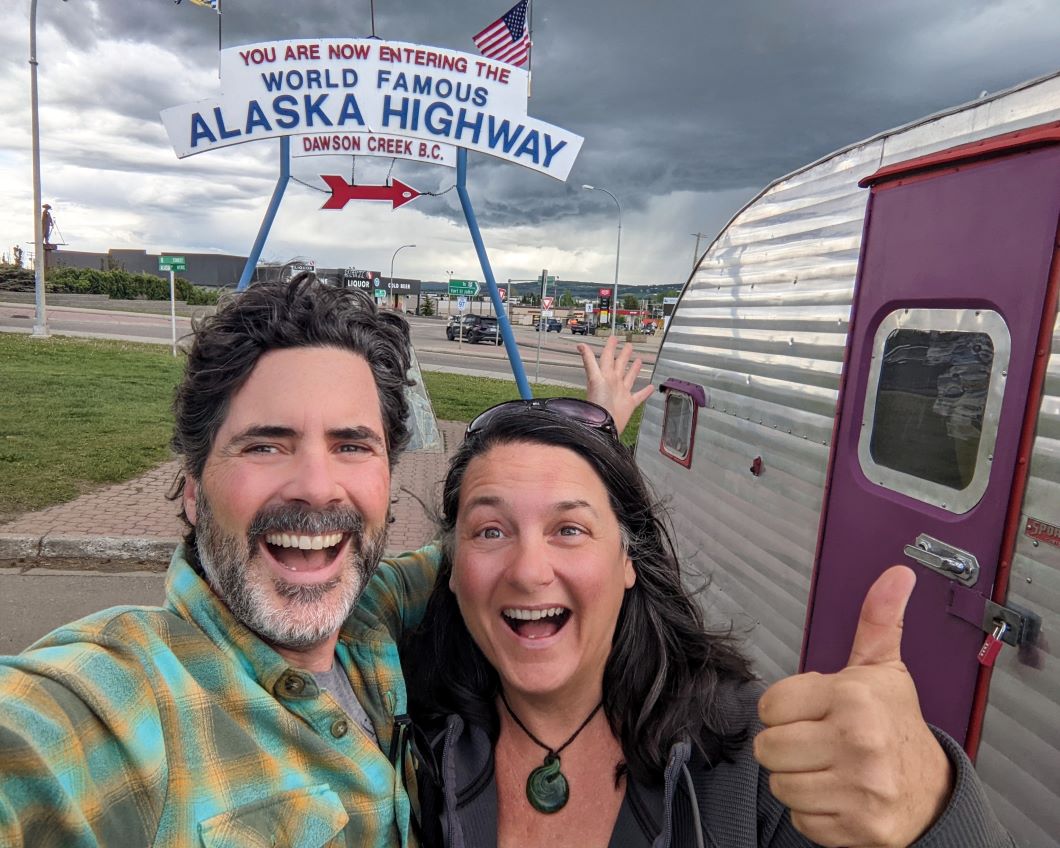
Shari Galiardi & David Hutchison have turned their higher education backgrounds, desire for life-long learning, and thirst for adventure travel into writing, photography, video production, and public speaking tours from coast to coast. Known to their friends as simply Shari & Hutch, you can learn more about their full-time, solar-powered adventures on their website at freedominacan.com. Or, follow them on Facebook, Instagram, and YouTube as “Freedom in a Can, LLC.”
Related articles:
From Law Enforcement to Off-Grid Adventures: Ash Browne's Solar-Powered Transformation Journey








